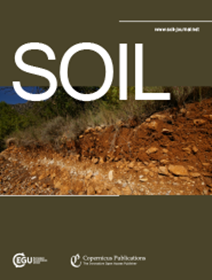钙与特定的土壤有机碳分解产物有关
IF 4.3
2区 农林科学
Q1 SOIL SCIENCE
引用次数: 0
摘要
摘要。钙(Ca)可能在更多的生态系统中对土壤有机碳(SOC)的保存做出了贡献。本研究表明,在不同的酸性土壤类型和不同的生态系统特征、不同的气候、母质、土壤类型和植被条件下,Ca与富含芳香和酚基的有机碳化合物共存。反过来,这种Ca - soc的共定位部分通过阳离子交换被去除,然后只有在Ca存在的分解过程中(Ca添加孵育)才能重新建立这种关联。因此,这突出了分解和Ca与SOC特征分数的共同定位之间的因果关系。分解增加了带负电官能团的相对比例,增加了SOC与Ca的关联倾向;反过来,这种关联可以抑制溶解的有机碳输出或进一步分解。我们认为这一机制可能是由微尺度局部分解过程中的Ca热点驱动的,从而解释了不同酸性土壤环境中Ca与特定组成的有机碳的共定位。将这一生物地球化学过程纳入地球系统模型可以提高我们对土壤碳动态的理解、预测和管理,并解释它们对富钙修正的反应。本文章由计算机程序翻译,如有差异,请以英文原文为准。
Calcium is associated with specific soil organic carbon decomposition products
Abstract. Calcium (Ca) may contribute to the preservation of soil organic carbon (SOC) in more ecosystems than previously thought. Here, we provide evidence that Ca is co-located with SOC compounds that are enriched in aromatic and phenolic groups, across different acidic soil types and locations with different ecosystem properties, differing in terms of climate, parent material, soil type, and vegetation. In turn, this co-localised fraction of Ca–SOC is removed through cation exchange, and the association is then only re-established during decomposition in the presence of Ca (Ca addition incubation). Thus, this highlights a causative link between decomposition and the co-location of Ca with a characteristic fraction of SOC. Decomposition increases the relative proportion of negatively charged functional groups, which can increase the propensity for the association between SOC and Ca; in turn, this association can inhibit dissolved organic carbon export or further decomposition. We propose that this mechanism could be driven by Ca hotspots at the microscale shifting local decomposition processes and thereby explaining the co-location of Ca with SOC of a specific composition across different acidic soil environments. Incorporating this biogeochemical process into Earth system models could improve our understanding, predictions, and management of carbon dynamics in soils, as well as accounting for their response to Ca-rich amendments.
求助全文
通过发布文献求助,成功后即可免费获取论文全文。
去求助
来源期刊

Soil
Agricultural and Biological Sciences-Soil Science
CiteScore
10.80
自引率
2.90%
发文量
44
审稿时长
30 weeks
期刊介绍:
SOIL is an international scientific journal dedicated to the publication and discussion of high-quality research in the field of soil system sciences.
SOIL is at the interface between the atmosphere, lithosphere, hydrosphere, and biosphere. SOIL publishes scientific research that contributes to understanding the soil system and its interaction with humans and the entire Earth system. The scope of the journal includes all topics that fall within the study of soil science as a discipline, with an emphasis on studies that integrate soil science with other sciences (hydrology, agronomy, socio-economics, health sciences, atmospheric sciences, etc.).
 求助内容:
求助内容: 应助结果提醒方式:
应助结果提醒方式:


